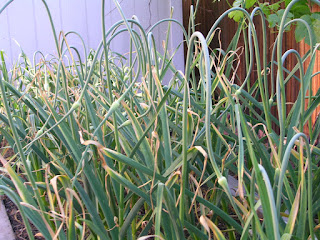The temperature reading this morning in Denver at 7:00 am was 46 degrees, right now (as of this writing) it's in the mid-50s, I say summer is over. So does the September calendar. NOT that you still can't harvest warm season vegetables (if covering at night) and watch the geraniums hang on with a few blooms. No doubt we'll have many warm days in the next few weeks, but probably not consistent nighttime temperatures above fifty-five, which is what warm season plants need.
There's still time - go buy some garlic planting stock from local garden retailers and get it in the ground now...or very soon!
Because I've written several garlic blogs, for the sake of not repeating or feeling the easy urge to cut and paste, below is a link to an earlier garlic writing. Not much has changed except that more local garden retailers are carrying quality planting stock and they are on their shelves. Planting stock sells out quickly so call around to check availability. If the good stuff is gone, check with mail order companies by doing a quick search. They often sell out as well, many have been taking fall shipping orders since early summer.
If you're resourceful and have healthy left over homegrown garlic that was harvested earlier this summer, then you know that it also doubles as planting stock. Choose from the largest bulbs and use the largest cloves to plant for large bulbs next summer.
Here's the planting link - Plant Garlic Now
"There is no such thing as a little garlic"














